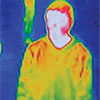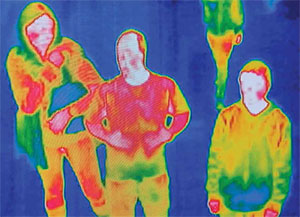
Smart Thermal Cameras
Prices are falling, capabilities increase with technology
- By John Romanowich
- Mar 01, 2013
There are more reasons than ever to choose thermal cameras for mainstream, outdoor security applications. As prices fall and capabilities increase, new applications are emerging that leverage the advantages offered by thermal technology for securing outdoor assets. The result is a market tipping point for thermal cameras and an opportunity to use the best detection technology available for costs that meet or beat less-effective approaches.
A Technological Breakthrough
 Thermal cameras have always been a good choice for security applications used during the night because they are able to “see in the dark,” protecting areas where lighting is unavailable or too costly to deploy. When combined with video analytics, thermal cameras offer real-time, pre-emptive security with instant notification of security violations. Recent advancements in the sensitivity of thermal imagers, combined with sophisticated image processing, make thermal cameras an accurate, 24-hour solution. Thermal cameras now present clear thermal images regardless of rain, humidity, fog or sun, delivering detail instead of blurrier images once associated with black-and-white technology. Cameras use a high degree of on-board video processing to emphasize small temperature variations between objects and the background to exaggerate the fine details in contrast to other image features.
Thermal cameras have always been a good choice for security applications used during the night because they are able to “see in the dark,” protecting areas where lighting is unavailable or too costly to deploy. When combined with video analytics, thermal cameras offer real-time, pre-emptive security with instant notification of security violations. Recent advancements in the sensitivity of thermal imagers, combined with sophisticated image processing, make thermal cameras an accurate, 24-hour solution. Thermal cameras now present clear thermal images regardless of rain, humidity, fog or sun, delivering detail instead of blurrier images once associated with black-and-white technology. Cameras use a high degree of on-board video processing to emphasize small temperature variations between objects and the background to exaggerate the fine details in contrast to other image features.
Better images reveal critical security information; image processing provides more accurate intrusion detection. When combined with lower prices, the result is an incomparable continuous security solution.
New Option for Theft Prevention
In the past, thermal cameras were typically deployed to protect large, critical infrastructure applications in which a disruption in operations would have serious economic impact. However, as smart, thermal cameras with on-board video analytics fall below the $5,000 price barrier, the technology now makes sense in less missioncritical environments. In fact, one of the most fundamentally security function, theft prevention, can now be addressed economically using the same sophisticated thermal camera solutions. Applications range from copper theft at electric substations, securing equipment at maintenance yards, protecting car parking lots, securing the millions of oil and gas well heads in use and other areas where theft prevention remains a key objective.
The prior approach for these applications has been to use a “blind” sensor, such as coax on the fence that acts as an intrusion detector, which required augmentation by a camera to determine the cause of the alert. These systems were not fully effective due to the sensors generating many nuisance alerts, and they were costly because they involved the use of two separate systems: a sensor system and a video system. Thermal detection cameras offer a functional advantage over these traditional solutions because thermal cameras simultaneously detect and “see” an alarm event 24-hours per day, providing instantaneous validation for prompt action.
The result is a viable, single-technology solution that reduces costs for securing and monitoring assets and facilities around the clock.
Cost-saving Camera Placement Advantages
New capabilities made possible through GPS analytics allow cameras to be mounted onto buildings and existing infrastructure in order for the cameras to look through fencing without nuisance alerts from objects on the other side. The cameras only alert when intruders enter a secure area. Mounting the cameras brings the total cost of the solution on par with, or even less than, other modalities for outdoor intrusion protection, which reduces the cost and complexity of bringing power and communications to the perimeter.
Waterside applications pose larger obstacles for mounting cameras because poles cannot be placed in the middle of a waterway. In cases such as protecting ports or dams, longer-range cameras allow security objectives to be archieved in a practical, less-costly manner, as infrastructure is often more expensive than the cost of the camera itself.
More Actionable Information
Smart, cost-effective thermal cameras open up a new world of understanding about what is happening outdoors beyond security, from early detection scenarios to looking at behavior that increases a company’s operational efficiency. For instance, a company could use a thermal camera to determine if there is a leak at a refinery, if transformers are overheating at a power station or to monitor storage tank levels.
The possibilities for thermal cameras extend to highway safety, measuring parking area occupancy or the volume of road traffic to automatically determining if a car is driving the wrong way on an on-ramp or road. New return on investments (ROI) scenarios and greater functionality now make smart, thermal cameras a perfect technology tool for such applications.
High-tech without High-cost
Smart, thermal cameras may seem like a high-tech solution, but the economics of these systems are becoming very cost-competitive with alternatives. The economic advantages of newer, outdoor, thermal imaging become clear by examining “perfoot” costs of securing a perimeter. While many manufacturers do not present their pricing in this way, the costs can be calculated, and the results are motivating a wider range of customers to adapt to or adopt this security approach. Thermal analytic camera systems are now available for as low as $10 per foot, making the most accurate perimeter security technology comparable in price to traditional, visible cameras with analytics, fence sensors or buried cable systems.
With the innovation of lower-cost, smart, thermal cameras with substantially more on-board image processing, video systems are available to accurately detect the presence of unauthorized persons and for a range of other applications, even in cost-sensitive markets where this technology was previously considered to be too expensive. These smart cameras are designed to filter the affects of environmental elements and provide accurate detection regardless of wind, weather or the movement of small animals, trees or blowing trash. When security and business operations receive accurate information, an appropriate response to the nature of the alert can be devised. Smart thermal video systems are providing a new, cost-effective tool for more uses in an expanding number of mainstream applications.
This article originally appeared in the March 2013 issue of Security Today.